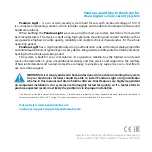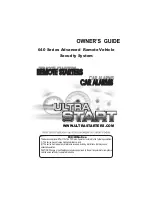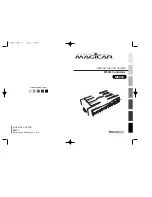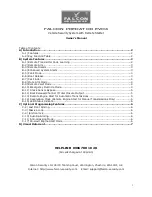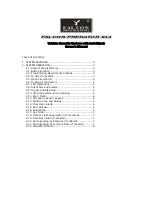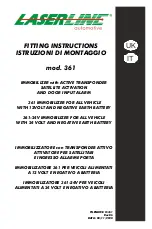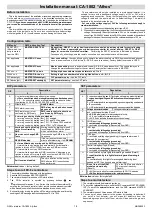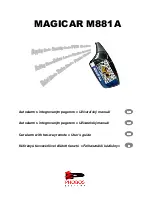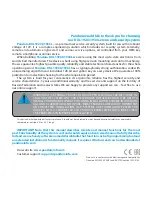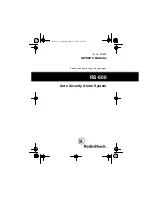
2) Removing the gear selector from the "park" position.
3) Opening the hood.
4) Opening a door. An open door will prevent the system from starting the engine;
if the engine has already been remotely started, opening a door will stop the
running engine 30 seconds later.
If a start command is sent from the transmitter, but any of the above conditions are
present, the system will not attempt to start the engine and will instead indicate the
violated safety circuit as follows:
1) Gear selector not in the "park" position produces one long and one short chirp.
2) An open hood produces one long and two short chirps.
3) An open door produces one long and three short chirps.
4) Pressed brake pedal produces one long and four short chirps.
To drive the vehicle away after remote starting, disarm the system (if needed) open
the door to enter the vehicle. At this point, the engine will remain running for 30
seconds longer. During this 30 second period, insert the key into the ignition switch
and turn the switch to "on" position (not "start"!). Then press the brake pedal; now the
engine is no longer running from the system, but rather from the ignition key.
Pit-Stop
TM
Feature: This feature allows you to turn the ignition switch off, re-
move your keys, leave the vehicle and lock your doors while leaving the engine
Page - 17
running. To use this feature, have your foot off of the brake pedal and press the
transmitter's LOCK and UNLOCK buttons for 2 seconds. The system will chirp and
flash the parking and dome lights once. The key can be removed from the ignition
switch and the engine will remain running for the programmed time period. During
this period, the engine can be turned off by pressing the LOCK and UNLOCK trans-
mitter buttons again for 2 seconds or by pressing the brake pedal.
Your system can have up to two additional outputs which offer further convenience
features. The first of these outputs, the "Option Output", is programmed to disarm
the system when it is utilized. The most common use for the Option Output is
remotely-activated trunk release. This output is activated by pressing and holding the
transmitter's OPTION button for two seconds, except when the ignition switch is "on".
However, this output may be operated when the ignition switch is "on" if the vehicle
has a door opened. The Option Output is also operable while the system is in Valet
Mode.
If the OPTION button is pressed for 2 seconds and then released, the output will
be momentary. If the OPTION button is held depressed, the output will remain for as
long as the button is held, for up to 15 seconds. The extended output operation is
useful for custom applications.
Option Output ("Trunk Release") and Additional Output
Page - 18
The further Additional Output is activated by pressing and holding the transmitter's
LOCK button for 2 seconds. Of course, the system will arm as soon as the LOCK
button is pressed. This output can also be activated for up to 15 seconds, as long as
the transmitter's LOCK button is held. This output can be used for customized
accessory operations. If desired, the Additional Output can be operated by the PANIC
button; this is a programmable feature, and is explained on page 42.
There are several distinct indications that the LED Status Light can show in normal
daily use; these are categorized into three areas: Security System Status, Automatic
Transmitter Verification
TM
, and Zone Violation.
System Status: The LED status light is a visual indicator of what state the security
system is in at any given time. It is normally positioned in a location that is easily
observed by the driver. There are 4 possible status conditions that the system can
be in, and are reflected by the LED status light:
-
Off
= The system is disarmed and not performing any automatic
functions.
-
On Constant
= The system is in the Valet Mode.
The LED Status Light
Page - 19
-
Flashing Slow
= The system is fully armed.
-
Flashing Fast
= The Last Door Arming or Automatic Rearming features are in
progress. This indication also occurs during the 3 second
arming delay (a 45 second arming delay is optional).
Automatic Transmitter Verification
TM
: After the ignition is turned "on", the LED
status light will flash to indicate the number of transmitters programmed to operate the
system. For example: two flashes and a pause indicates that only two transmitters
are programmed to operate the system. This display is shown for 10
seconds every time the ignition switch is turned "on". More importantly, for 48 hours
after any transmitter programming has occurred, the siren or horn will chirp for two
seconds and the LED status light will flash for 90 seconds. This warning protects
against unauthorized transmitters from being added to your system.
Zone Violation: If the system is activated, the LED status light will start to flash
and pause the following coded sequences to indicate which protected circuit caused
the activation. This will be seen at all times, until the ignition switch is turned "on",
which will clear the system's memory. The unit's memory can store four different
codes, and if multiple violations involving different zones occurred, the different zones
will be shown in the order of the violation.
-
Flash-2x & Pause
= System was activated from the hood or trunk circuit.
Page - 20













